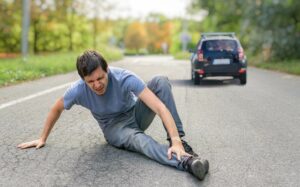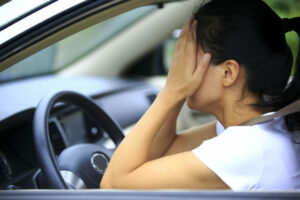Do you ever have the feeling that you just can’t stay in one place? That you have to keep moving, even if it’s just a little bit? If so, you might be experiencing symptoms of hit-and-run OCD. This type of OCD is characterized by an intense need to constantly move, even if it doesn’t make sense. In this blog post, we will discuss what hit-and-run OCD is, as well as how to manage the condition.
Contents
What Is Hit And Run OCD?
 Hit and run OCD is a subtype of OCD that is characterized by intense anxiety and fear related to the possibility of hitting someone with a car. People with hit and run OCD may obsessively check for signs that they have hit someone, even if there is no evidence that they have done so. They may also compulsively avoid driving or places where they could potentially hit someone.
Hit and run OCD is a subtype of OCD that is characterized by intense anxiety and fear related to the possibility of hitting someone with a car. People with hit and run OCD may obsessively check for signs that they have hit someone, even if there is no evidence that they have done so. They may also compulsively avoid driving or places where they could potentially hit someone.
According to studies, this condition is a relatively new phenomenon, only recently being recognized as a distinct subtype of OCD. It is not yet clear what causes hit-and-run OCD, but it is believed to be related to other types of OCD that involve fears of harm or responsibility for others.
For example, it can come under the harm OCD type, where a person fears they will hit someone while driving. Or, it might come under the responsibility OCD type, where a person is afraid they will be responsible for hitting someone even if they are not at fault.
Hit and run OCD can be extremely debilitating, as it can severely restrict a person’s ability to drive or go about their daily life. Therefore, if you or someone you know is dealing with this type of disorder then seek out today to get the help and support needed.
What Are Some Signs To Recognize?
There are several types of signs and symptoms to help you recognize the condition. Some common signs that you may have are listed below:
- Obsess whether or not you hit someone or something when you were driving
- Go back to the scene of the alleged accident to look for evidence that you hit something
- Replay the event in your mind over and over again
- Feel extreme anxiety about hitting a pedestrian, animal, or object
- Have trouble sleeping or concentrating because you’re so preoccupied with the event
These are some of the common symptoms that you might have if you’re struggling with hit-and-run OCD. Moreover, your intrusive thoughts can be extremely distressing and can be prompted by some incidents. Let’s discuss some of the situations where you might see an increase in your hit-and-run OCD. These include:
- looking down for your radio to change certain music
- running over the littered road
- mistakenly hitting the pothole or speed breaker
- hearing the horns, sirens, and screeches of the brake
- driving on a busy road
So basically these can be the trigger for your OCD type. And further you might suffer from a cycle of obsession to hit someone from your vehicle. Therefore hit and run OCD is actually a difficult condition to deal with. You need professional treatment to help yourself from these types of obsessions and compulsions.
What Causes Hit and Run OCD?
 There is no one specific cause of hit-and-run OCD. However, some risk factors may make you more susceptible to developing the disorder. Let’s take a look at some of the most common ones:
There is no one specific cause of hit-and-run OCD. However, some risk factors may make you more susceptible to developing the disorder. Let’s take a look at some of the most common ones:
Family history of OCD or other anxiety disorders
If someone in your family has OCD, you may be more likely to develop the disorder yourself. This is usually due to a combination of genetic and environmental factors. In fact, studies have shown that OCD tends to run in families. More often than not, if someone in your family has OCD, you may be more likely to develop the disorder yourself.
Childhood trauma or abuse
If you experienced a traumatic event during childhood, you may be more likely to develop hit-and-run OCD. This is because trauma can cause changes in the brain that make you more prone to anxiety and other mental health disorders. For example, if you experienced a hit-and-run accident as a child, you may be more likely to develop the disorder.
Stressful life events
If you’ve recently gone through a major life event (such as a divorce or the death of a loved one), you may be more likely to develop hit-and-run OCD. This is because stressful life events can trigger changes in the brain that make you more vulnerable to anxiety and other mental health disorders.
So these are some of the common causes that may develop hit-and-run OCD. However, it’s important to remember that everyone is different and there is no one specific cause of the disorder.
Moreover, let’s list out some of the potential risk factors of hits and run OCD:
- Previous exposure to accident
- Substance abuse
- Other comorbid mental disorders such as depression or anxiety
- Past injury
As you can see, there are a number of potential risk factors that may contribute to the development of hit-and-run OCD. However, it’s important to remember that everyone is different and there is no one specific cause of the disorder. If you think you may be at risk of developing hit-and-run OCD, it’s important to talk to your doctor or mental health professional. They can help you assess your risk and provide you with the resources and support you need.
How Does It Impact Everyday Life?
 Hit and run OCD is actually quite common, and can have a profound impact on a person’s life. The main symptom of hit-and-run OCD is the constant fear of hitting someone with your car. It is important to manage this condition to the further consequences. Let’s first discuss some of the common consequences, these include:
Hit and run OCD is actually quite common, and can have a profound impact on a person’s life. The main symptom of hit-and-run OCD is the constant fear of hitting someone with your car. It is important to manage this condition to the further consequences. Let’s first discuss some of the common consequences, these include:
Agoraphobia
This is something that can develop over time as a result of hit-and-run OCD. Agoraphobia is the fear of being in situations where you feel like you can’t escape. This can make going to work, school, or even leaving the house extremely difficult. In fact, it is not uncommon for people with agoraphobia to become housebound.
Anxiety
The anxiety caused by hit-and-run OCD can be crippling. It can make it difficult to concentrate, sleep, or even eat. The anxiety can also lead to panic attacks. The constant fear of hitting someone can also lead to a feeling of isolation and loneliness. Moreover, anxiety is often accompanied by depression.
Avoidance of driving
When you are dealing with Hit and Run OCD, one of the main things that you will want to avoid is driving. This is because when you are driving, you are more likely to be in an accident. Even if you are a very careful driver, there is always the possibility that you could hit someone with your car. If you are someone who is dealing with this type of OCD, it is important to find other ways to get around it. You may want to consider taking public transportation or riding a bike.
Not leaving home
 This is another avoidance tactic that people with hit-and-run OCD may use. If you are afraid of hitting someone with your car, you may not want to leave your home. This can be extremely isolating and make it difficult to live a normal life. In fact, avoidance is one of the main things that keeps people with OCD stuck in their disorder.
This is another avoidance tactic that people with hit-and-run OCD may use. If you are afraid of hitting someone with your car, you may not want to leave your home. This can be extremely isolating and make it difficult to live a normal life. In fact, avoidance is one of the main things that keeps people with OCD stuck in their disorder.
If you are avoiding driving because of your hit-and-run OCD, it is important to seek treatment. A qualified therapist can help you to slowly and safely expose yourself to your fear. In fact, there are several treatments available, you just need to find the one that works best for you. With treatment, it is possible to manage your OCD and live a normal life.
How To Manage Hit And Run OCD?
When it is creating significant distress or interference in daily life, professional treatment may be warranted. Treatment usually consists of medication and/or therapy. Let’s discuss treatment options and some tips to self-manage the conditions.
Exposure therapy
This type of therapy involves gradually exposing the person to an anxiety-provoking situation or object. The goal is to help the person manage their anxiety in a healthy way and eventually be able to confront the thing they’re afraid of. For example, it may be helpful to:
- make a list of feared objects or situations related to hit-and-run OCD
- rank them from least to most anxiety-provoking
- begin practicing exposure with the least anxiety-provoking object or situation on the list
So, this ERP therapy can be very effective in treating hit-and-run OCD. As this works, the individual is able to challenge and change their beliefs about OCD.
Cognitive-behavioral therapy (CBT)
This type of therapy focuses on helping people change their thinking and behavior. It can be helpful in treating hit-and-run OCD. CBT is believed to be one of the most effective treatments for OCD. The main goal of CBT is to create a healthy relationship with your thoughts. This is done by learning to challenge and change unhealthy thinking patterns. The main aim of this therapy is:
- help you understand your thoughts and feelings better
- challenge the negative thinking that is associated with OCD
- teach you how to manage and cope with your OCD symptoms
- help you to take control of your life back from OCD
CBT can be done in individual or group therapy sessions. It usually lasts for 12-16 weeks. The number of sessions and length of time will depend on the severity of your OCD and how well you respond to treatment.
Support groups
 It is believed that about half of all people with OCD will experience some form of hit-and-run OCD during their lifetime. This type of OCD can be extremely distressing and debilitating. So a support group can be very helpful. There are a number of support groups available for people with hit-and-run OCD. These groups can provide valuable support and information.
It is believed that about half of all people with OCD will experience some form of hit-and-run OCD during their lifetime. This type of OCD can be extremely distressing and debilitating. So a support group can be very helpful. There are a number of support groups available for people with hit-and-run OCD. These groups can provide valuable support and information.
Moreover, it is important to understand that there are several types of support groups. For example, some are led by mental health professionals and some are peer-led. It is important to find a group that you feel comfortable with. Because the goal of a support group is to provide you with support, information, and understanding.
In addition, online support groups are also available. And these can be a great resource for people with hit-and-run OCD. These groups can provide support and understanding from the comfort of your own home.
Self-help tips
Along with professional help, there are things you can do to self-manage your hit-and-run OCD. Here are some tips:
Increase your understanding of OCD
The more you know about the condition, the less power it has over you. When you are afraid of the dark, but then you turn on the light and see that there is nothing to be afraid of, learning about OCD can help lessen your symptoms and make them more manageable. For example, if you know that your thoughts are just thoughts and not reality, you can better manage them.
Talk about your fears
Identifying and talking about your fears can help you to better understand them and what triggers them. Also, talking about your fears can help to lessen their power. In fact, research has shown that talking about your fears can help to decrease the intensity of your symptoms. As this is not always easy to do, you may want to talk to a therapist or other mental health professional about your fears.
Challenge your thoughts
Once you identify your fears, you can start to challenge them. For example, if you are afraid of getting in a car accident, challenge that thought by thinking about all the times you have driven without being in an accident. Or, if you are afraid of getting sick, challenge that thought by thinking about all the times you have been healthy. The more you challenge your fears, the less power they will have over you.
Avoid avoidance
It may seem counterintuitive, but avoiding your fears will only make them worse. For example, if you are afraid of driving, avoiding driving will only make your fear worse. The more you face your fears, the less power they will have over you. So you should try to expose yourself to your fears in a gradual and controlled way. In this way, there are chances that you can gradually reduce your symptoms.
Incorporate healthy habits
 Healthy habits are important for overall health and well-being, but they can also help to reduce the symptoms of OCD. For example, exercise has been shown to be an effective treatment for OCD. These include:
Healthy habits are important for overall health and well-being, but they can also help to reduce the symptoms of OCD. For example, exercise has been shown to be an effective treatment for OCD. These include:
- Eating a healthy diet
- Getting enough sleep
- Managing stress
These things can actually help to lessen your symptoms and make them more manageable. So if you are struggling with hit-and-run OCD, consider incorporating some of these healthy habits into your life.
So these are some overall helpful tips to manage hit-and-run OCD. If you think you may be struggling with the condition, it is important to seek professional help. A mental health professional can help you to understand your symptoms and develop a treatment plan that is right for you. With the right help, you can manage your hit-and-run OCD and live a healthy and happy life.
Conclusion
To conclude, hit and run OCD is a subtype of OCD that is characterized by intrusive thoughts, images, or urges related to hitting someone with a car. In fact, this may be the only thing that a person with hit-and-run OCD is obsessed about. While there is no known cure for OCD, there are treatments that can help reduce the symptoms. These include exposure and response prevention therapy, medication, and support groups.
If you or someone you know is struggling with hit-and-run OCD, it’s important to seek professional help. With treatment, it is possible to manage the symptoms and live a healthy and quality life. For more information, you can contact Therapy Mantra.
Therapy Mantra is a platform that provides mental health resources and connects individuals with mental health professionals. If you’re looking for a therapist, we can help! Contact us today to learn more about our services. You can also book an online counseling and therapy session or download our free OCD treatment app on Android or iOS.


